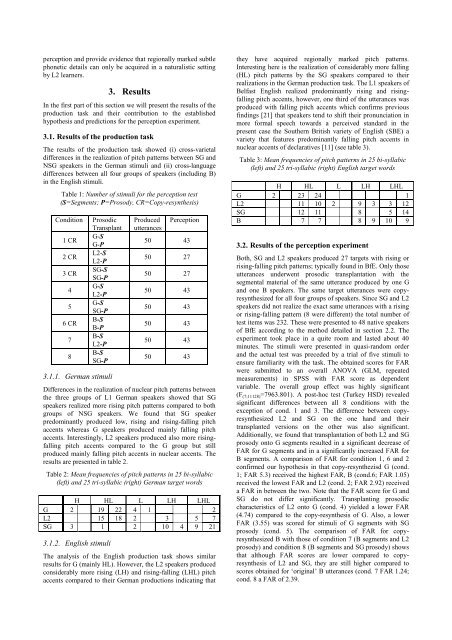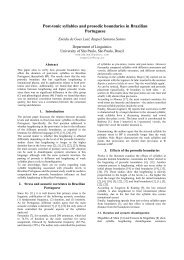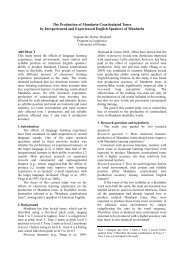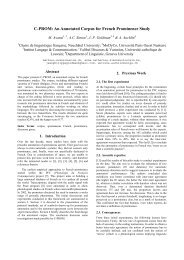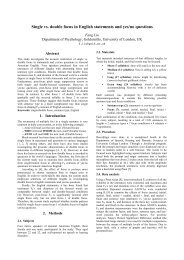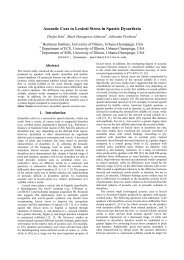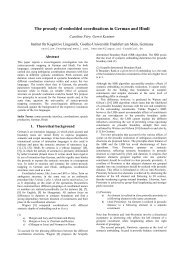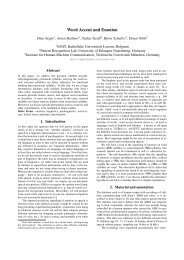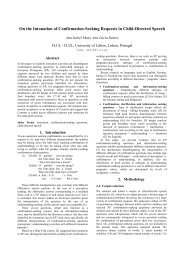Belfast Intonation in L2 speech - Speech Prosody 2010
Belfast Intonation in L2 speech - Speech Prosody 2010
Belfast Intonation in L2 speech - Speech Prosody 2010
You also want an ePaper? Increase the reach of your titles
YUMPU automatically turns print PDFs into web optimized ePapers that Google loves.
perception and provide evidence that regionally marked subtle<br />
phonetic details can only be acquired <strong>in</strong> a naturalistic sett<strong>in</strong>g<br />
by <strong>L2</strong> learners.<br />
3. Results<br />
In the first part of this section we will present the results of the<br />
production task and their contribution to the established<br />
hypothesis and predictions for the perception experiment.<br />
3.1. Results of the production task<br />
The results of the production task showed (i) cross-varietal<br />
differences <strong>in</strong> the realization of pitch patterns between SG and<br />
NSG speakers <strong>in</strong> the German stimuli and (ii) cross-language<br />
differences between all four groups of speakers (<strong>in</strong>clud<strong>in</strong>g B)<br />
<strong>in</strong> the English stimuli.<br />
Table 1: Number of stimuli for the perception test<br />
(S=Segments; P=<strong>Prosody</strong>, CR=Copy-resynthesis)<br />
Condition Prosodic<br />
Transplant<br />
G-S<br />
1 CR<br />
G-P<br />
<strong>L2</strong>-S<br />
2 CR<br />
<strong>L2</strong>-P<br />
SG-S<br />
3 CR<br />
SG-P<br />
G-S<br />
4<br />
<strong>L2</strong>-P<br />
G-S<br />
5<br />
SG-P<br />
B-S<br />
6 CR<br />
B-P<br />
B-S<br />
7<br />
<strong>L2</strong>-P<br />
B-S<br />
8<br />
SG-P<br />
3.1.1. German stimuli<br />
Produced<br />
utterances<br />
Perception<br />
50 43<br />
50 27<br />
50 27<br />
50 43<br />
50 43<br />
50 43<br />
50 43<br />
50 43<br />
Differences <strong>in</strong> the realization of nuclear pitch patterns between<br />
the three groups of L1 German speakers showed that SG<br />
speakers realized more ris<strong>in</strong>g pitch patterns compared to both<br />
groups of NSG speakers. We found that SG speaker<br />
predom<strong>in</strong>antly produced low, ris<strong>in</strong>g and ris<strong>in</strong>g-fall<strong>in</strong>g pitch<br />
accents whereas G speakers produced ma<strong>in</strong>ly fall<strong>in</strong>g pitch<br />
accents. Interest<strong>in</strong>gly, <strong>L2</strong> speakers produced also more ris<strong>in</strong>gfall<strong>in</strong>g<br />
pitch accents compared to the G group but still<br />
produced ma<strong>in</strong>ly fall<strong>in</strong>g pitch accents <strong>in</strong> nuclear accents. The<br />
results are presented <strong>in</strong> table 2.<br />
Table 2: Mean frequencies of pitch patterns <strong>in</strong> 25 bi-syllabic<br />
(left) and 25 tri-syllabic (right) German target words<br />
H HL L LH LHL<br />
G 2 19 22 4 1 2<br />
<strong>L2</strong> 15 18 2 3 5 7<br />
SG 3 1 2 10 4 9 21<br />
3.1.2. English stimuli<br />
The analysis of the English production task shows similar<br />
results for G (ma<strong>in</strong>ly HL). However, the <strong>L2</strong> speakers produced<br />
considerably more ris<strong>in</strong>g (LH) and ris<strong>in</strong>g-fall<strong>in</strong>g (LHL) pitch<br />
accents compared to their German productions <strong>in</strong>dicat<strong>in</strong>g that<br />
they have acquired regionally marked pitch patterns.<br />
Interest<strong>in</strong>g here is the realization of considerably more fall<strong>in</strong>g<br />
(HL) pitch patterns by the SG speakers compared to their<br />
realizations <strong>in</strong> the German production task. The L1 speakers of<br />
<strong>Belfast</strong> English realized predom<strong>in</strong>antly ris<strong>in</strong>g and ris<strong>in</strong>gfall<strong>in</strong>g<br />
pitch accents, however, one third of the utterances was<br />
produced with fall<strong>in</strong>g pitch accents which confirms previous<br />
f<strong>in</strong>d<strong>in</strong>gs [21] that speakers tend to shift their pronunciation <strong>in</strong><br />
more formal <strong>speech</strong> towards a perceived standard <strong>in</strong> the<br />
present case the Southern British variety of English (SBE) a<br />
variety that features predom<strong>in</strong>antly fall<strong>in</strong>g pitch accents <strong>in</strong><br />
nuclear accents of declaratives [11] (see table 3).<br />
Table 3: Mean frequencies of pitch patterns <strong>in</strong> 25 bi-syllabic<br />
(left) and 25 tri-syllabic (right) English target words<br />
H HL L LH LHL<br />
G 2 23 24 1<br />
<strong>L2</strong> 11 10 2 9 3 3 12<br />
SG 12 11 8 5 14<br />
B 7 7 8 9 10 9<br />
3.2. Results of the perception experiment<br />
Both, SG and <strong>L2</strong> speakers produced 27 targets with ris<strong>in</strong>g or<br />
ris<strong>in</strong>g-fall<strong>in</strong>g pitch patterns; typically found <strong>in</strong> BfE. Only those<br />
utterances underwent prosodic transplantation with the<br />
segmental material of the same utterance produced by one G<br />
and one B speakers. The same target utterances were copyresynthesized<br />
for all four groups of speakers. S<strong>in</strong>ce SG and <strong>L2</strong><br />
speakers did not realize the exact same utterances with a ris<strong>in</strong>g<br />
or ris<strong>in</strong>g-fall<strong>in</strong>g pattern (8 were different) the total number of<br />
test items was 232. These were presented to 48 native speakers<br />
of BfE accord<strong>in</strong>g to the method detailed <strong>in</strong> section 2.2. The<br />
experiment took place <strong>in</strong> a quite room and lasted about 40<br />
m<strong>in</strong>utes. The stimuli were presented <strong>in</strong> quasi-random order<br />
and the actual test was preceded by a trial of five stimuli to<br />
ensure familiarity with the task. The obta<strong>in</strong>ed scores for FAR<br />
were submitted to an overall ANOVA (GLM, repeated<br />
measurements) <strong>in</strong> SPSS with FAR score as dependent<br />
variable. The overall group effect was highly significant<br />
(F (7;11128)=7963.801). A post-hoc test (Turkey HSD) revealed<br />
significant differences between all 8 conditions with the<br />
exception of cond. 1 and 3. The difference between copyresynthesized<br />
<strong>L2</strong> and SG on the one hand and their<br />
transplanted versions on the other was also significant.<br />
Additionally, we found that transplantation of both <strong>L2</strong> and SG<br />
prosody onto G segments resulted <strong>in</strong> a significant decrease of<br />
FAR for G segments and <strong>in</strong> a significantly <strong>in</strong>creased FAR for<br />
B segments. A comparison of FAR for condition 1, 6 and 2<br />
confirmed our hypothesis <strong>in</strong> that copy-resynthezisd G (cond.<br />
1; FAR 5.3) received the highest FAR, B (cond.6; FAR 1.05)<br />
received the lowest FAR and <strong>L2</strong> (cond. 2; FAR 2.92) received<br />
a FAR <strong>in</strong> between the two. Note that the FAR score for G and<br />
SG do not differ significantly. Transplant<strong>in</strong>g prosodic<br />
characteristics of <strong>L2</strong> onto G (cond. 4) yielded a lower FAR<br />
(4.74) compared to the copy-resynthesis of G. Also, a lower<br />
FAR (3.55) was scored for stimuli of G segments with SG<br />
prosody (cond. 5). The comparison of FAR for copyresynthesized<br />
B with those of condition 7 (B segments and <strong>L2</strong><br />
prosody) and condition 8 (B segments and SG prosody) shows<br />
that although FAR scores are lower compared to copyresynthesis<br />
of <strong>L2</strong> and SG, they are still higher compared to<br />
scores obta<strong>in</strong>ed for „orig<strong>in</strong>al‟ B utterances (cond. 7 FAR 1.24;<br />
cond. 8 a FAR of 2.39.


